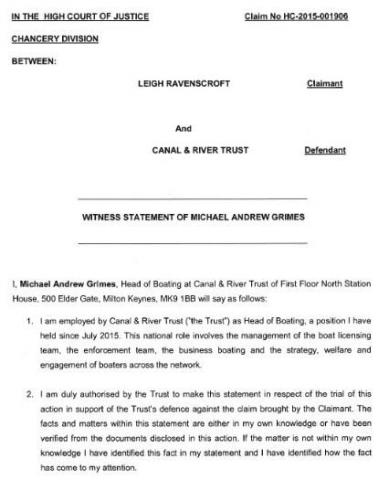Did C&RT's Head of Boating fall or was he pushed?
February 2017 - Allan Richards looks at the departure of C&RT's Head of Boating and the messy court case that may have a role in his exit.
Some speculation has been caused by the sudden announcement that Mike Grimes, C&RT’s Head of Boating, will leave at Easter having ‘regrettably decided to step down’.
Has he jumped or was he pushed? This speculation is increased by the revelation that he has not left to take up a position elsewhere but “plans to take some time off over the summer to decide on his next challenge”.
In fairness, it should be stated that this is not the first time Mr Grimes has had a career break. Between leaving his position as Head of Customer Operations (Gatwick) for British Airways and joining C&RT as Head of Business Boating, he took time out to restore a property in the Fens.
He was Head of Business Boating for just four months after joining C&RT in April 2015, when his role was expanded to cover private boating as well. It says something of C&RT attitudes that his promotion was announced as follows – ‘We've appointed Mike Grimes to the position of head of boating, bringing his current responsibilities for business boating together with our licensing and enforcement departments.’
Mr Grimes describes his role more fully as follows on linkedin: ‘Leading national, multi-channel frontline teams across a broad customer interface including boat licencing, enforcement, business trade (b2b) and customer service to develop and implement the customer experience strategy to exceed customer expectation and maximise commercial return. Leading on customer transformation across the boating portfolio to improve the customer proposition through an end-to end self-serve strategy, improved customer facilities and services, the delivery of water-based destination plans to enhance the visitor experience and licence reform to simplify customer contact while reducing cost and improving income.’
How much was actually delivered in Mr Grimes short tenure as Head of Boating is debatable. Suffice to say, and as revealed in the Floater last month (Question time for the boating team 4/1/2017)’, even the promised regular engagement with boaters via frequent web chats in 2016 did not take place.
That aside, the most obvious reason for Mr Grimes departure is his recent witness statement related to the case of Leigh Ravenscroft vs C&RT.
For those not familiar with this case, on 26th January 2015 Leigh Ravenscroft’s boat was seized by C&RT on the basis that it did not have a Pleasure Boat Certificate (PBC) allowing use of the River Trent.
It was also seized on the basis that there were arrears of PBC fees which were due. Mr Ravenscroft is now asking the court to make a number of declarations and also award damages of over £8,000, this being the amount that C&RT demanded from him before returning his boat.
The main issue to be decided will be if he was required to have a PBC. A PBC is only required for use of the ‘main navigable channel’ of the river. However, there are also two subsidiary issues. One is ‘are C&RT under a duty to act proportionately and to pursue remedies other than seizure where they are available?’ The other subsidiary issue relates to Section 8 of the British Waterways Act 1983. Does this allow C&RT seize and keep a boat as security for outstanding fees which are due?
C&RT has already admitted in documents filed with court that Section 8 does not allow seizure due to debt (alleged or otherwise). Following Mr Ravenscroft’s action, the Trust are claiming seizure on this basis was simply a ‘mistake’.
It has offered no explanation to the court as to how this ‘mistake’ came to be made or how similar ‘mistakes’ have been made in the past.
Mike Grimes' witness statement comes as something of a surprise. It suggests that Shoosmiths (C&RT’s solicitors) advised him that there was no public right of navigation on C&RT’s rivers.
In reality, this argument was lost in the High Court some five years previously with British Waterways failing to appeal it and both BW and C&RT accepting that public rights of navigation exist on their rivers.
Mr Grimes witness statement is also not helped by him skirting round the issue of ‘main navigable channel’. The former Waterways Ombudsman took BW to task in 2011 over this point. She stated, in no uncertain terms, that contradictory interpretations were being placed on the same legislation.
Having provided a witness statement (or perhaps being ordered to provide a witness statement by his superiors) means that he should be called as a witness.
As such, It will be left to him to explain how his staff made the ‘mistake’ of seizing Mr Ravenscroft’s boat on the basis that there were arrears of PBC fees. He will also be called upon to explain why a boat outside the main navigable channel needs a PBC and also why C&RT did not act proportionately by using the appropriate legislation.
Having been set up (or perhaps setting himself up) as C&RT’s fall guy, the important question is not ‘has he jumped or was he pushed?’ Rather the question is does he intend to attend court once he is no longer an employee of C&RT?
Nigel Moore, who is representing Leigh Ravenscroft has claimed that the ideas and arguments put forward by Mike Grimes are risible and he would be horribly embarrassed under cross examination. However, he does not feel Mr Grimes attendance as a witness would affect the outcome of the case anyway. Mr Grimes, it would appear, may be a disposable victim rather than a perpetrator in the matter of Ravenscroft vs C&RT.
For many boaters, it is C&RT’s directors and trustees that should be making the witness statements in defence of their policies and their interpretation of the law rather than somebody they employed after the event took place.
Photos: (Top) Mike Grimes' witness statement to the High Court, and (Bottom) Mike Grimes, C&RT's Head of Boating.







